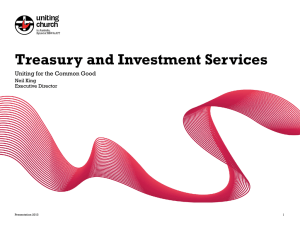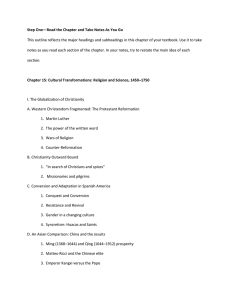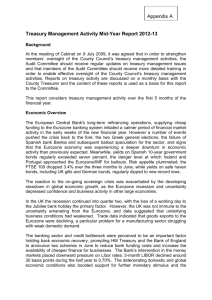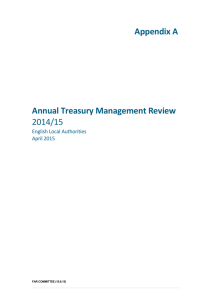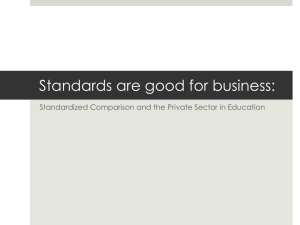Attachment: 14
advertisement
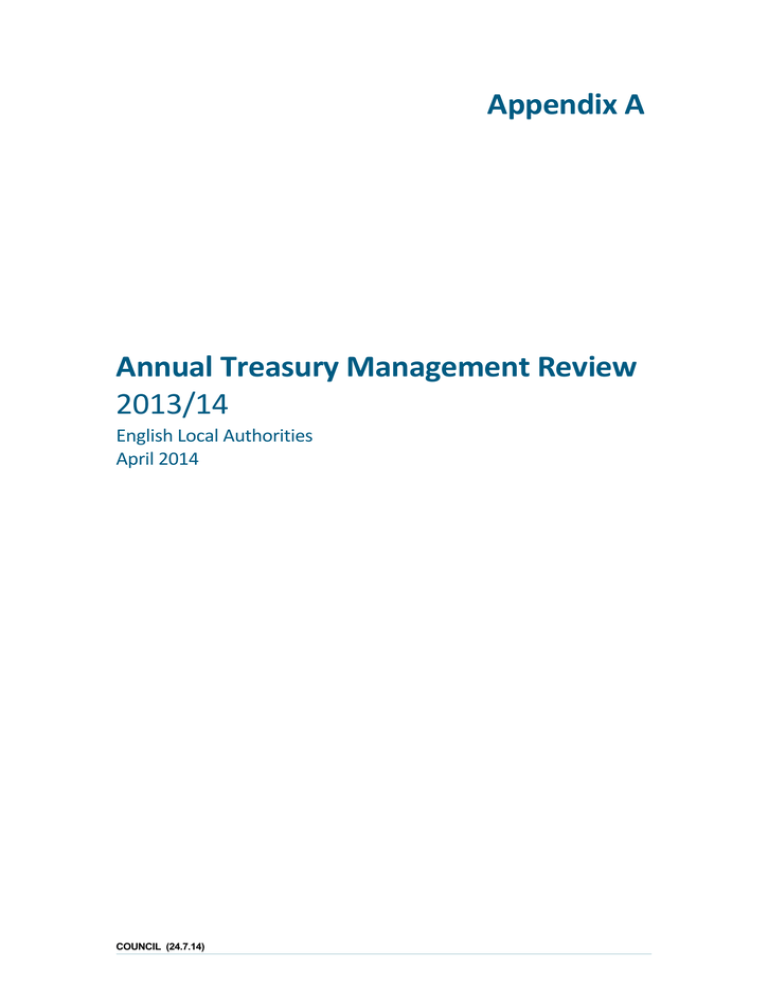
Appendix A Annual Treasury Management Review 2013/14 English Local Authorities April 2014 COUNCIL (24.7.14) 2 Contents Purpose .............................................................................................................. 3 Executive Summary .......................................................................................... 4 Recommendations ............................................................................................ 4 Introduction and Background ......................................................................... 5 1. The Council’s Capital Expenditure and Financing 2013/14 ...... 5 2. The Council’s Overall Borrowing Need ....................................... 6 3. Treasury Position as at 31 March 2014 ..................................... 8 4. The Strategy for 2012/13 ........................................................... 10 5. The Economy and Interest Rates............................................... 11 6. Borrowing Rates in 2013/14 ...................................................... 12 7. Borrowing Outturn for 2013/14 ................................................ 12 8. Investment Rates in 2013/14 ..................................................... 13 9. Investment Outturn for 2013/14 .............................................. 14 10. Other Issues ......................................................................... 17 COUNCIL (24.7.14) 3 Annual Treasury Management Review 2013/14 Purpose This Council is required by regulations issued under the Local Government Act 2003 to produce an annual treasury management review of activities and the actual prudential and treasury indicators for 2013/14. This report meets the requirements of both the CIPFA Code of Practice on Treasury Management (the Code) and the CIPFA Prudential Code for Capital Finance in Local Authorities (the Prudential Code). During 2013/14 the minimum reporting requirements were that the full Council should receive the following reports: an annual treasury strategy in advance of the year (Council 13/02/2013) a mid-year (minimum) treasury update report (Council 10/12/2013) an annual review following the end of the year describing the activity compared to the strategy (this report) In addition, Cabinet has received quarterly treasury management update reports. The regulatory environment places responsibility on members for the review and scrutiny of treasury management policy and activities. This report is, therefore, important in that respect, as it provides details of the outturn position for treasury activities and highlights compliance with the Council’s policies previously approved by members. This Council confirms that it has complied with the requirement under the Code to give prior scrutiny to all of the above treasury management reports by the Finance, Audit and Risk Committee before they were reported to the full Council. COUNCIL (24.7.14) 4 Executive Summary During 2013/14, the Council complied with its legislative and regulatory requirements. The key actual prudential and treasury indicators detailing the impact of capital expenditure activities during the year, with comparators, are as follows: Prudential and treasury indicators Capital expenditure 2012/13 Actual £000 2013/14 Original £000 2013/14 Actual £000 2,472 8,429 11,526 -32,982 -27,306 -23,322 External debt 4,265 3,660 3,060 Investments Longer than 1 year Under 1 year Total 7.00 40.33 47.33 0 41.4 41.4 7.75 29.78 37.53 Capital Financing Requirement: Capital spend was increased during the year from an original budget of £8.429M to an actual of £11.526M. This was mainly due to the purchase of the District Council Offices and the capitalised lump sum contribution to the pension fund. Other prudential and treasury indicators are to be found in the main body of this report. The Strategic Director of Finance also confirms that no borrowing was undertaken for a capital purpose and the statutory borrowing limit (the authorised limit) was not breached. The Council did exceed its Operational Boundary for external debt by £0.319M for nine days in December. This is the limit beyond which external debt is not normally expected to exceed but was breached due to a shortfall in cashflow. The shortfall is thought to have been bought about by the impact on annual cashflow trends of changes to local government finance in 2013/14, such as the retention of business rates and the option for taxpayers to pay council tax by 12 monthly instalments instead of 10. The financial year 2013/14 continued the challenging investment environment of previous years, namely low investment returns. Recommendations The Council is recommended to: 1. 2. Approve the actual 2013/14 prudential and treasury indicators in this report Note the annual treasury management report for 2013/14 COUNCIL (24.7.14) 5 Introduction and Background This report summarises the following: Capital activity during the year; Impact of this activity on the Council’s underlying indebtedness (the Capital Financing Requirement); The actual prudential and treasury indicators; Overall treasury position identifying how the Council has borrowed in relation to this indebtedness, and the impact on investment balances; Summary of interest rate movements in the year; Detailed debt activity; and Detailed investment activity. 1. The Council’s Capital Expenditure and Financing 2013/14 The Council undertakes capital expenditure on long-term assets. These activities may either be: Financed immediately through the application of capital or revenue resources (capital receipts, capital grants, revenue contributions etc.), which has no resultant impact on the Council’s borrowing need; or If insufficient financing is available, or a decision is taken not to apply resources, the capital expenditure will give rise to a borrowing need. The actual capital expenditure forms one of the required prudential indicators. The table below shows the actual capital expenditure and how this was financed. £m General Fund 2012/13 Actual £000 2013/14 Working Budget £000 2013/14 Actual £000 Capital expenditure 2,472 10,232 11,526 Financed in year 1,336, 2,457 1,866 Unfinanced capital expenditure 1,136 7,775 9,660 COUNCIL (24.7.14) 6 2. The Council’s Overall Borrowing Need The Council’s underlying need to borrow for capital expenditure is termed the Capital Financing Requirement (CFR). This figure is a gauge of the Council’s debt position. The CFR results from the capital activity of the Council and what resources have been used to pay for the capital spend. It represents the 2013/14 unfinanced capital expenditure (see above table), and prior years’ net or unfinanced capital expenditure which has not yet been paid for by revenue or other resources. Part of the Council’s treasury activities is to address the funding requirements for this borrowing need. Depending on the capital expenditure programme, the treasury service organises the Council’s cash position to ensure that sufficient cash is available to meet the capital plans and cash flow requirements. This may be sourced through borrowing from external bodies (such as the Government, through the Public Works Loan Board [PWLB] or the money markets), or utilising temporary cash resources within the Council. Reducing the CFR – the Council’s underlying borrowing need (CFR) is not allowed to rise indefinitely. Statutory controls are in place to ensure that capital assets are broadly charged to revenue over the life of the asset. The Council has a negative CFR so is not required to make an annual revenue charge, called the Minimum Revenue Provision – MRP, to reduce the CFR. MRP is effectively a repayment of the borrowing need. This differs from the treasury management arrangements which ensure that cash is available to meet capital commitments. External debt can also be borrowed or repaid at any time, but this does not change the CFR. The total CFR can also be reduced by: the application of additional capital financing resources (such as unapplied capital receipts); or charging more than the statutory revenue charge (MRP) each year through a Voluntary Revenue Provision (VRP). The Council’s 2013/14 MRP Policy (as required by CLG Guidance) was approved as part of the Treasury Management Strategy Report for 2013/14 on 13/02/2014. Because the Council is in the unusual position of having a negative CFR there is no requirement currently to make an annual revenue charge (MRP). The Council’s CFR for the year is shown below, and represents a key prudential indicator. It includes finance leasing schemes on the balance sheet, which increase the Council’s borrowing need. No borrowing is actually required against these schemes as a borrowing facility is included in the contract (if applicable). COUNCIL (24.7.14) 7 CFR (£m): General Fund 31 March 2013 Actual £000 31 March 2014 Actual £000 -35,167 -32,982 Add unfinanced capital expenditure (as above) 1,136 9,660 LAMS 1,000 0 0 0 49 19 -32,982 -23,303 Opening balance Less MRP/VRP* Less finance lease repayments Closing balance Borrowing activity is constrained by prudential indicators for net borrowing and the CFR, and by the authorised limit. Gross borrowing and the CFR - in order to ensure that borrowing levels are prudent over the medium term and only for a capital purpose, the Council should ensure that its gross external borrowing does not, except in the short term, exceed the total of the capital financing requirement in the preceding year (2013/14) plus the estimates of any additional capital financing requirement for the current (2014/15) and next two financial years. This essentially means that the Council is not borrowing to support revenue expenditure. This indicator allows the Council some flexibility to borrow in advance of its immediate capital needs in 2013/14. The table below highlights the Council’s gross borrowing position against the CFR. The Council has complied with this prudential indicator. 31 March 2013 Actual 31 March 2014 Budget 31 March 2014 Actual Gross borrowing position £2.265m £1.659m £1.659m CFR -£32.98m -£27.31m -£23.30m The authorised limit - the authorised limit is the “affordable borrowing limit” required by s3 of the Local Government Act 2003. Once this has been set, the Council does not have the power to borrow above this level. The table below demonstrates that during 2013/14 the Council has maintained gross borrowing within its authorised limit. The operational boundary – the operational boundary is the expected borrowing position of the Council during the year. Periods where the actual position is either below or over the boundary is acceptable subject to the authorised limit not being breached. Actual financing costs as a proportion of net revenue stream - this indicator identifies the trend in the cost of capital (borrowing and other long term obligation costs net of investment income) against the net revenue stream. COUNCIL (24.7.14) 8 2013/14 Authorised limit £8.0M Maximum gross borrowing position £6.32M Operational boundary £6.0M Average gross borrowing position £2.17M Financing costs as a proportion of net revenue stream -3.35% 3. Treasury Position as at 31 March 2014 The Council’s debt and investment position is organised by the treasury management service in order to ensure adequate liquidity for revenue and capital activities, security for investments and to manage risks within all treasury management activities. Procedures and controls to achieve these objectives are well established both through member reporting detailed in the summary, and through officer activity detailed in the Council’s Treasury Management Practices. At the beginning and the end of 2013/14 the Council‘s treasury position was as follows: TABLE 1 31 March 31 March Rate/ Rate/ 2013 2014 Return Return Principal Principal Fixed rate funding: -PWLB £1.265M 8.49% £0.660M 8.39% -Market £3.000M 9.17% £2.400M 9.09% Variable rate funding: -PWLB £0M £0M -Market £0M £0M Total debt £4.265M CFR Over / (under) borrowing Investments: -£32.98M -£23.30M £41.245M £26.36M - in house £1.33M 0.45% £1.03M 0.50% £46M 2.30% £36.5M 1.52% £47.33m 2.30% £37.53M 1.52% - Cash Managers Total investments COUNCIL (24.7.14) 8.53 £3.060M 8.53 9 The exposure to fixed and variable rates was as follows: 31 March 2013 Actual Fixed rate (principal) Variable rate (principal) 2013/14 Original Limits 31 March 2014 Actual £36.32MCr £27.4MCr £39.1M £33.50MCr £6.75MCr £0 - £11.7MCr £4.03MCr The maturity structure of the debt portfolio was as follows: 31 March 2013 actual 2013/14 original limits 31 March 2014 actual Under 12 months £2.606M £2.087M £2.087M 12 months and within 24 months £0.087M £0.057M £0.057M 24 months and within 5 years £1.116M £1.076M £1.076M 5 years and within 10 years £0.088M £0.093M £0.093M 10 years and above £0.368M £0.347M £0.347M The maturity structure of the investment portfolio was as follows: 2012/13 Actual £000 Investments Longer than 1 year Under 1 year Total COUNCIL (24.7.14) 2013/14 Actual £000 7.00 40.33 47.33 7.75 29.78 37.53 10 4. The Strategy for 2013/14 The strategy in 2013/14 was to continue only lending to UK banks and building societies. Only UK banks with a credit rating, for longer term deals, greater than “BBB” and F3 or above for short term credit ratings were on the Council’s lending list. (These are Fitch definitions of ratings). Not all building societies are credit rated but this did not preclude them from the lending list as lending to a building society was dependant on their asset size. Where a society did have a rating, this was considered at the time of the deal taking into account the amount of investment and the length of the deal. As well as imposing maximum limits with each counter party, the overall percentage of outstanding investments with each counterparty was assessed to ensure a reasonable spread of investments. Change in strategy during the year – the strategy adopted in the original Treasury Management Strategy Report for 2013/14, approved by the Council on 13/02/2013, was not subjected to any revision during the year. COUNCIL (24.7.14) 11 5. The Economy and Interest Rates The original expectation for 2013/14 was that the Bank Rate would not rise during the year and for it only to start gently rising from quarter 1 2015. This forecast rise has now been pushed back to a start in quarter 3 2015. Economic growth (GDP) in the UK was virtually flat during 2012/13 but surged strongly during the year. Consequently there was no additional quantitative easing during 2013/14 and Bank Rate ended the year unchanged at 0.5% for the fifth successive year. While CPI inflation had remained stubbornly high and substantially above the 2% target during 2012, by January 2014 it had, at last, fallen below the target rate to 1.9% and then fell further to 1.7% in February. It is also expected to remain slightly below the target rate for most of the two years ahead. Gilt yields were on a sharply rising trend during 2013 but volatility returned in the first quarter of 2014 as various fears sparked a flight to quality. The Funding for Lending Scheme, announced in July 2012, resulted in a flood of cheap credit being made available to banks which then resulted in money market investment rates falling drastically in the second half of that year and continuing into 2013/14. That part of the Scheme which supported the provision of credit for mortgages was terminated in the first quarter of 2014 as concerns rose over resurging house prices. The UK coalition Government maintained its tight fiscal policy stance but recent strong economic growth has led to a cumulative, (in the Autumn Statement and the March Budget), reduction in the forecasts for total borrowing, of £97bn over the next five years, culminating in a £5bn surplus in 2018-19. The EU sovereign debt crisis subsided during the year and confidence in the ability of the Eurozone to remain intact increased substantially. Perceptions of counterparty risk improved after the ECB statement in July 2012 that it would do “whatever it takes” to support struggling Eurozone countries; this led to a return of confidence in its banking system which has continued into 2013/14 and led to a move away from only very short term investing. However, this is not to say that the problems of the Eurozone, or its banks, have ended as the zone faces the likelihood of weak growth over the next few years at a time when the total size of government debt for some nations is likely to continue rising. Upcoming stress tests of Eurozone banks could also reveal some areas of concern. COUNCIL (24.7.14) 12 6. Borrowing Rates in 2013/14 PWLB borrowing rates - the graphs and table for PWLB certainty maturity rates below show, for a selection of maturity periods, the high and low points in rates, the average rates, spreads and individual rates at the start and the end of the financial year. 7. Borrowing Outturn for 2013/14 Borrowing - Four loans were drawn to fund a temporary short fall in cash flow of which three were repaid prior to year end: The loans drawn were: Principal Type Interest Rate Maturity City of Edinburgh Council £1.00m Fixed Interest Rate 0.5% 46 Days Rhondda Cynon Taff County Borough Council £2.61m Fixed Interest Rate 0.3% 9 Days Rhondda Cynon Taff County Borough Council £1.00m Fixed Interest Rate 0.35% 9 Days Lender COUNCIL (24.7.14) 13 Derbyshire County Council £1.40m Fixed Interest Rate 0.4% 31 Days Principal Type Interest Rate Maturity East Riding Yorkshire Council £2.00m Fixed interest rate 0.45% 20 days City of Edinburgh Council £1.00m Fixed Interest Rate 0.5% 46 Days Rhondda Cynon Taff County Borough Council £2.61m Fixed Interest Rate 0.3% 9 Days Rhondda Cynon Taff County Borough Council £1.00m Fixed Interest Rate 0.35% 9 Days PWLB £0.605m Fixed interest rate Various Various The loans repaid were: Lender The average borrowing rate increased from 8.975% to 9.915% due to loans maturing during the year with relatively low interest rates. Rescheduling No rescheduling was done during the year as the average 1% differential between PWLB new borrowing rates and premature repayment rates made rescheduling unviable. 8. Investment Rates in 2013/14 Bank Rate remained at its historic low of 0.5% throughout the year; it has now remained unchanged for five years. Market expectations as to the timing of the start of monetary tightening ended up almost unchanged at around the end of 2014 / start of 2015. The Funding for Lending Scheme resulted in deposit rates remaining depressed during the whole of the year, although the part of the scheme supporting provision of credit for mortgages came to an end in the first quarter of 2014. COUNCIL (24.7.14) 14 9. Investment Outturn for 2013/14 Investment Policy – the Council’s investment policy is governed by CLG guidance, which was been implemented in the annual investment strategy approved by the Council on 13/02/13. This policy sets out the approach for choosing investment counterparties, and is based on credit ratings provided by the Fitch credit rating agency for banks and asset size for building society investments. This is supplemented by spreading the investments over a number of counterparties. The investment activity during the year conformed to the approved strategy. Investments placed by Cash Managers – the Council uses two external cash managers to invest its cash balances. At the start of the year both had £23m to invest. During the year eight investments were not reinvested when they matured to fund the capital programme. Sterling ended the year with £16.5m and Tradition had £20m. The performance of the managers against the benchmark return was: Cash Manager Investments Placed Interest Sterling £23M - £16.5M £23M - £20M Tradition Total £46M - £36.5M *Ave 3 Month LIBID Rate 0.39% Ave 7 days notice Rate 0.29% Return Benchmark* £0.301M 1.50% 0. 39% £0.336M 1.47% 0.29% £0.637M 1.47% This compares with an original budget of £0.645M. COUNCIL (24.7.14) 15 Ave. Int. Rate Deals made in 1st Qtr % Ave. Int. Ave. Int. Ave. Int. Rate Deals Rate Deals Rate Deals made in made in made in 2nd Qtr% 3rd Qtr % 4th Qtr % Ave. Int. Rate Deals made in Year Ave. Int. Rate for All Investments during Year % NHDC 0.48 0.48 0.47 0.47 0.48 0.48 Sterling 0.79 1.04 1.47 0 1.14 1.5 Tradition 1.01 1.09 1.00 0 1.04 1.47 The table below summaries where investments were held at 31 March: Investments 31 March 2013 Investments 31 March 2014 Banks £10.08m £7.03m Building Societies £37.25m £30.50m Local Authorities - - £47.33m £37.53m Total The pie chart below shows the spread of investment balances as at 31 March 2014. The figures shown are in millions whilst the figure in brackets denotes the value of the building societies total assets: (1) Building Societies with Assets over £4.5bn (2) Building Societies with Assets between £2.5bn - £4.5bn (3) Building Societies with Assets between £1.0bn - £2.5bn (4) Building Societies with Assets between £0.3bn - £1.0bn Ulster Bank Nat West Bank £1.00M £1.03M Manchester (4) Yorkshire (1) £1.00M £1.50M Principality (1) £1.00M Placement of Investments Barclays Bank £1.00M Leeds (1) £5.25 Furness (4) Market £4.00M Harborough (4) £1.50M National Counties (3) Melton Mowbray £1.50M (4) £3.00M Hanley Economic (4) Marsden (4) £1.75 Lloyds TSB £3.00M £1.75M Progressive (3) Cumberland (3) £2.00M £3.00M Hinckley & Royal Bank of Rugby (4) £2.00M Scotland £2.25M COUNCIL (24.7.14) Leeds (1) £5.25 Furness (4) £4.00M Melton Mowbray (4) £3.00M Marsden (4) £3.00M Cumberland (3) £3.00M Royal Bank of Scotland £2.25M Hinckley & Rugby (4) £2.00M Progressive (3) £2.00M Lloyds TSB £1.75M Hanley Economic (4) £1.75 National Counties (3) £1.50M Market Harborough (4) £1.50M Yorkshire (1) £1.50M 16 The average daily balance of investments was £49.349m with balances varying between £36.86m and £58.09m. £0.668m of interest was generated from investments during the year. This is slightly more than the estimated interest of £0.667m. The original estimate of £0.677m was reduced by £0.023m in the first quarter to £0.644 and adjusted by £0.013m in the second and third quarters to reflect the higher rate of interest achieved on investments made by the cash managers. Interest Accrued to 31 March £ Interest Received by 31 March £ Total Interest for the Year £ NHDC 26,137 4,068 30,205 Sterling 94,311 206,934 301,245 Tradition 124,528 211,583 336,111 Total 244,976 422,585 667,561 Investments held by the Council - the Council maintained an average balance of £6.37m of internally managed funds. The internally managed funds earned £30,205 of interest with an average rate of return of 0.48%. This equates to the working budget assumption of £0.030m. Investments held by Sterling - Sterling maintained an average balance of £20.12M managed funds. This generated £0.301M interest and earned an average rate of return of 1.50%. Investments held by Tradition – Tradition maintained an average balance of £22.87M managed funds. This generated £0.336M interest and earned an average rate of return of 1.47%. COUNCIL (24.7.14) 17 The graph below shows the maturity profile of investments at 31st March 2014. 10. Other Issues Local Authority Mortgage Scheme (LAMS) This is a mortgage scheme which will help first time buyers take their first step on to the housing ladder. Under the scheme, first time buyers will only need a 5% deposit to buy their first home, with local councils guaranteeing a further 20%, giving them access to lower mortgage rates. Prospective buyers will still need to be able to afford their mortgage repayments, but will not need to save the large deposit that lenders now ask for, with 20-25% of the price of a property being common place. In November 2012 the Council has deposited funds of £0.5M with both Lloyds Bank and Leeds Building Society as guarantee for 20%. This has been matched by HCC. This is a 5 year scheme which earns the Council 2.14% interest with Lloyds and 2.9% with Leeds (£10.7K and £14.5K per annum respectively). These rates are fixed for the 5 year period. The Council’s funds remain with Lloyds and Leeds and will only be called on if a mortgagor defaults on their repayments. Interest earned from this arrangement will be held in a reserve outside of the General Fund and used if a default occurs. After the five year period has elapsed, the remaining balance will be transferred back to the General Fund. Change of Bank Towards the end of 2013/14 the Council went out to tender for it’s banking service. Lloyds bank won the tender and as from the 1st April Lloyds have replaced HSBC as the Council’s bankers. The change of banks has resulted in savings in the General Fund. COUNCIL (24.7.14) Oct 15 Sept 15 Aug 15 July15 June 15 Period May 15 Feb 15 Jan 15 Dec 14 Nov 14 Oct 14 Sept 14 Aug 14 July 14 June 14 May 14 6.00 5.00 4.00 3.00 2.00 1.00 0.00 Apr 14 Investment £ Investment Maturity March 2014
